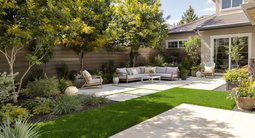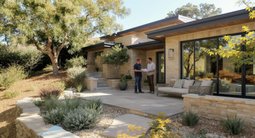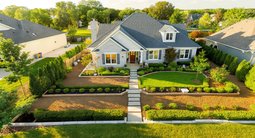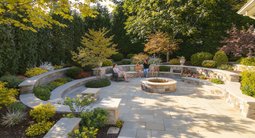TL;DR
Start with structure, then layer plants. Keep main paths 36–48 inches wide, patios sloped 1–2% for drainage, and group plants in repeating drifts for a polished, low-maintenance native landscape design. If you learn visually, upload a photo to ReimagineHome.ai to preview small backyard layouts, privacy screens, and budget-friendly hardscaping before you dig: https://www.reimaginehome.ai/?utm_source=blog
From ‘I Just Planted Stuff’ to a Yard That Actually Looks Planned

Planting in odd numbers and layering heights creates balance and beginner-friendly beauty.
If your yard looks like a random plant experiment gone rogue — you’re not alone. Many first-time gardeners dive in with enthusiasm (“I have seed, I have dirt, let’s go!”) only to end up with uneven heights, clashing colors, and plants that either vanish or take over the place. The good news? You don’t need a degree in horticulture or the patience of a monk to fix it. Start by thinking less like a botanist and more like a storyteller: where do your eyes travel first, and what mood do you want the space to have? Use simple visual rules — tall in back, medium in the middle, short in front — and group plants in odd numbers for balance. Add structure with a few paths or borders, repeat colors to tie areas together, and take it one patch at a time. Think of it as editing, not overhauling. You’re curating nature, not controlling it — and every season teaches you something new about what thrives, what dies, and what accidentally looks amazing.
Why Outdoor Design and Curb Appeal Matter Right Now
Primary garden paths typically range from 36–48 inches wide for comfortable use. A yard looks finished when circulation, drainage, and planting layers work together. Define a clear route to the door, right-size the patio, and plant in masses for rhythm; then fill with native perennials for color and habitat. This simple landscaping design approach raises curb appeal and reduces maintenance without blowing the budget. - At a glance overview — top priorities: drainage first, then layout clarity, then materials, then planting. - Drainage, layout clarity, materials, plant choices, outdoor living flow. - Modern curb appeal upgrades and before/after expectations. Want to see these ideas on your home? Try ReimagineHome.ai using just a photo: https://www.reimaginehome.ai/?utm_source=blog
Anecdote
A homeowner working from a sunroom hated the soggy lawn view. They swapped a patchy 12×18 lawn for a permeable patio, added a sedge matrix with coneflowers in repeating drifts, and planted a three-shrub privacy arc. Rain now drains, the laptop view is layered, and weekend maintenance dropped to under an hour.
Why Landscaping, Gardening & Hardscaping Are Changing
Hardscape elements often account for 50–70% of a low-maintenance yard budget. Climate shifts and water limits are pushing designs toward drought-tolerant and native plant landscaping, permeable paving, and shade-first thinking. Work-from-home lifestyles demand privacy, quiet seating pockets, and night lighting that extends use. Homeowners want strong structure: gravel paths, stone edges, raised beds, and resilient plant palettes that look good year-round with less fuss.
Key Landscaping & Hardscaping Trends (and How ReimagineHome.ai Shows Them)
Experts recommend a 1–2% slope for patios for proper drainage. - Layered planting and year-round structure - Stone, gravel, and stepping-stone paths - Outdoor rooms, seating pockets, fire pits - Drought-tolerant and native planting layouts - Modern curb appeal changes that boost value ReimagineHome.ai lets you preview materials, lighting, grading cues, and planting massing in minutes. Upload your facade or backyard, test a 10×12 concrete or paver patio, add a decomposed-granite path, swap edging from steel to stone, and toggle evening lighting. You can visualize matrix planting—grasses as a base, perennials in drifts, and shrubs as anchors—so spacing, mature size, and bloom succession make sense before you plant.
How to Use ReimagineHome.ai to Visualize Yards, Paths & Patios
For airflow and maintenance, shrubs should be planted 18–24 inches from foundations. 1. Upload a clear exterior or yard photo. 2. Pick a style or function (low-maintenance, modern, family-friendly, native habitat, or small yard privacy). 3. Test path shapes (straight, curve, keyhole), patio sizes (10×10 for a café set; 12×16 for dining + grill), steps, and terraces. 4. Experiment with planting layers: 30–40% structural (shrubs/evergreens), 40–60% matrix (grasses/sedges), 10–20% seasonal color. Add solar bollards and downlights to check night safety. 5. Generate multiple versions and compare before committing. Save the best plan and a materials list to share with a contractor or DIY on weekends.
Real-World Stories — Landscaping & Hardscaping in Action
Thoughtful front yard updates can significantly increase perceived home value. - A small urban yard redesigned with raised beds and stepping stones for usable space. A 42-inch path and two 4×8 raised beds formed a keyhole loop; sedge matrix cut weeding by half. Outcome: no more trampled plants, easy watering, and a tidy look from the sidewalk. - A seller improving curb appeal ahead of listing. A 12×12 paver landing, steel edging, and three repeating shrub masses (inkberry holly) organized the front. Outcome: faster sale and fewer weekend chores; mulch was replaced with gravel for cleaner edges. - A family yard transformed for play, privacy, and low upkeep. A 16×18 patio sloped 1.5% with permeable joints drains well; native grasses screen neighbors within two seasons. Outcome: dry seating after storms, less mowing, and a green privacy wall by year two.Common Mistakes in Landscaping & Hardscaping (and Fixes)
Over half of first-time projects underestimate walkway widths. - Over-paving or under-paving - Ignoring grading and drainage - Planting too close to structures - Using materials that don't match climate - Insufficient lighting layers Fixes: Right-size surfaces to use—dining needs about 3 feet per chair clearance; add a 1–2% slope away from the house and a gravel sub-base for patios; keep shrubs 18–24 inches off walls and trees 10–15 feet from foundations; choose freeze-thaw tolerant pavers in cold regions and light-toned stone in hot climates; layer path, task, and ambient lighting for safe movement. ReimagineHome.ai previews widths, slopes, and night lighting so you catch issues before buying a single paver.Pro Tips for Long-Lasting Landscaping & Hardscaping
Seat walls are most comfortable at 17–19 inches high. - Limit material palettes to 2–3 complementary tones - Design for year-round structure and seasonal shifts - Plan for sight lines from inside and outside - Account for microclimates and sun exposure - Layer plants for depth, airflow, and maintenance easeVisualization Scenario
Upload a straight-on photo of your front walk. In ReimagineHome.ai, widen the path to 42 inches, add steel edging with gravel bands, and insert three repeating shrub groups. Toggle evening lighting, then compare versions with light vs. dark pavers to pick your final curb appeal palette.
FAQ
- How do I design a small backyard layout? Keep main paths 36 inches wide, create one 10×12 patio for seating, and use vertical layers—tall in back, medium in the middle, low at edges. Repeat 2–3 plant types in drifts for cohesion and choose multi-season natives for less upkeep. - How do I create low-maintenance landscaping? Replace lawn with a grass/sedge matrix, add 2–3 shrub anchors per bed, and use permeable gravel or pavers. Rule: plant on 12–18-inch centers for quick cover, mulch lightly the first season, and choose drought-tolerant natives like prairie dropseed, coneflower, and inkberry holly. - Can I preview landscaping ideas using a photo? Yes. Upload a picture to ReimagineHome.ai, select a style, and visualize paths, patios, plant masses, and lighting in minutes. It’s ideal for testing drainage-friendly hardscaping and small backyard privacy layouts. - How far should shrubs be from my foundation? Keep shrubs 18–24 inches off walls for airflow and maintenance access; trees typically 10–15 feet away depending on mature spread. - What materials work best for modern hardscaping? Concrete, large-format pavers, and crushed gravel. Rule-of-thumb: use a 4–6-inch compacted base under pavers and a 1–2% surface slope away from structures for long-term durability and drainage.
Visualize Your Home’s Next Chapter
Even 100 square feet can become a morning coffee terrace when the layout is clear and the plants are right-sized. Picture crisp stepping stones under dappled shade, grasses moving in the breeze, and a low wall that doubles as extra seating for friends. Evening downlights make arrivals welcoming; a small fire bowl turns weeknights into rituals. Before you break ground, explore every possibility. Try ReimagineHome.ai with a single photo: https://www.reimaginehome.ai/?utm_source=blog
.svg)

.svg)










.png)